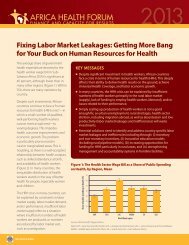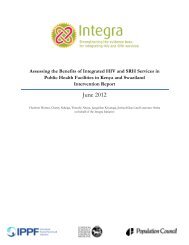ujh78
ujh78
ujh78
You also want an ePaper? Increase the reach of your titles
YUMPU automatically turns print PDFs into web optimized ePapers that Google loves.
Sex and geographic disparities<br />
In general, there was no sex disparities related to the distance to the water source in sub-Saharan<br />
Africa (see Figure 4.7). In Chad, however, the percentage of children who were living more than a 15-<br />
minute walk from the water source was more than 2 percentage points higher for females (58%) than for<br />
males (56%) (see Table 4.3).<br />
In every country with the exception of Liberia, a greater proportion of rural children than urban<br />
children lived more than a 15-minute walk from a water source (see Figure 4.8). Geographic disparities of<br />
at least 40 percentage points were seen in Kenya (urban: 14% and rural: 54%), Uganda (urban: 32% and<br />
rural: 76%), Niger (urban: 14% and rural: 55%), and Ethiopia (urban: 31% and rural: 76% (see Table<br />
4.3). The urban-rural difference was the reverse in Liberia: 18% of children in urban areas and 12% of<br />
children in rural areas lived more than a 15-minute walk from the water source (a difference of 6<br />
percentage points).<br />
The role of the household head’s sex and age<br />
Whether children with a male or a female head of household were more likely to live more than a<br />
15-minute walk from the primary water source varied across the countries (see Figure 4.9). In eight<br />
countries the percentage living far from water was at least one percentage point higher for children living<br />
with a male household head (see Table 4.3). In nine countries the percentage was at least one percentage<br />
point higher for children living with a female household head.<br />
Major differences by sex of head of household appeared in Ghana (male household head: 32%<br />
versus female household head: 22%) and Senegal (18% versus 7%) (see Figure 4.9). Additionally, the<br />
difference between children living with a male or female household head was more than 70 percentage<br />
points in Kenya (male household head: 47% and female household head: 55%) and Zimbabwe (34% and<br />
41%).<br />
The age of the household head was especially important in Namibia. The percentage of children<br />
living more than a 15-minute walk from the primary water source was 16 percentage points higher for<br />
children living with a household head at least age 50 (39%) than for their counterparts who lived with a<br />
younger head of household (23%) (see Table 4.3 and Figure 4.10 ).<br />
Variations during the last 13 years<br />
Benin, Cameroon, Ethiopia, and Rwanda all experienced large increases in the percentage of<br />
children living more than a 15-minute walk from a primary water source (see Figures 4.11 and 4.12). This<br />
increase—10 percentage points—was most evident in Ethiopia, where the percentage increased from 61%<br />
in 2005 to 70% in 2011 (see Table 4.2).<br />
Senegal demonstrated a major improvement in the percentage of children living more than a 15-<br />
minute walk from the primary water source, with a reduction of 28 percentage points from 2005 (44%) to<br />
2010-11 (17%). Other countries that experienced important reductions—more than 15 percentage<br />
points—included Lesotho (2004: 55% and 2009: 39%), Mali (2001: 29% and 2006: 12%), and Nigeria<br />
(2003: 53% and 2008: 35%).<br />
61








